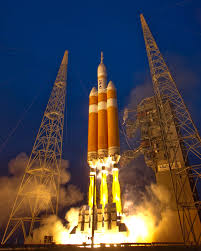Six years after the public statement of NASA’s intent to send a man on Mars (in 2011), here comes new details on the next steps of the great human adventure that enrich what is already known, namely that in their hangars they are building the most powerful rocket ever produced, the Space Launch System (SLS) and the Orion space capsule.
One of the top NASA managers, Bill Gerstenmaier, confirmed that next year will be made the first rocket launch and outlined a possible scenario for the next 15-20 years, to prepare for the first human trip to Mars.
STEP 1: DEEP SPACE GATEWAY. In the next decades the US space agency will prepare in lunar orbit the launching pad for the Mars expedition that is planned around the thirties. This first phase, dubbed Deep Space Gateway (DSG), involves the construction of an international space station around the Moon: it will not be permanently inhabited, but crews of four people take turns there for periods of about 40 days . The DSG might consist of a module for propulsion, a living module and laboratories and probably an airlock for spacewalks.
There will be perhaps a robotic arm, like that of the International Space Station, and a glass dome that will offer a panoramic view to the Moon and Earth.
The DSG will be assembled in 2025 in the course of 3 flights with NASA rocket and it is likely that the space agency will rely on private companies for supply flights. In addition to the technology, it will be an important preparatory phase also from a psychological point of view: it is to build and live in an outpost from which it is not easy to quickly return on the Earth. On the contrary, from the DSG will be easy to reach the Moon, and this could involve private companies to participate in to this adventure.




STEP 2: DEEP SPACE TRANSPORT. After the phase 1, the DSG will be a spaceport, where a vehicle will dock with the large crew: Deep Space Transport (DST). Afterwards will take place a long period of testing, around 1000 days, and then the DST will be launched to Mars. Although the early stages have been carved into the rock, what follows is all in the realm of fantasy: it can be only imagined the journey of the new Ulysses on Mars and its mysteries, while the DST will return to the lunar station to be replenished for at least another two trips.
THE SPACE SHIP. According to the NASA the spacecraft to Mars will have a diameter of 8.4 meters, hence will be larger than a module of the International Space Station ISS, that do not exceed 4.3 m in diameter, and its weigh should be around 41 tons. If all will go as planned, it will be launched around 2027. In 2029, the spacecraft will be inhabited by a crew that will live for a year, and in 2033 will begin its epic journey. To earn thrust the spacecraft will pass close to Venus, something that the crew could also vaunt in its journey diary.
WHATCING WITHOUT LANDING? It is not yet clear what could be the involvement of private companies or other space agencies, such as the European Space Agency and the Russian Space Agency. But above all, there is a big question in this story: it is not certain that during that mission will take place a descent on Mars, and it even seems like this is postponed to subsequent missions. Assuming that this twenty year plan proceeds as expected, without hitches or incidents, would be really a pity if the crew arrives around the Red Planet, without being able to land after a long trip and many risks encountered..
